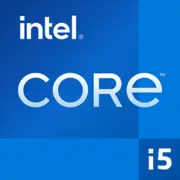Intel Core i5-13420H

Intel Core i5-13420H: The Balance of Power and Battery Life for Modern Laptops
March 2025
The Intel Core i5-13420H processor, released in 2023, remains a relevant choice for mid-range laptops even after two years. Its hybrid Raptor Lake architecture and balanced specifications make it a versatile option for work, study, and light gaming. Let's explore who this chip is suitable for and what to consider when choosing a device based on it.
Architecture and Process Technology: A Hybrid Approach for Efficiency
Raptor Lake is an evolution of Intel's hybrid architecture that combines Performance cores (P-cores) and Efficient cores (E-cores). The i5-13420H features 4 P-cores with Hyper-Threading (8 threads) and 4 E-cores (4 threads), totaling 8 cores and 12 threads. The base frequency is 2.1 GHz, with a maximum Turbo Boost frequency of 4.6 GHz.
Intel 7 (10nm Enhanced SuperFin) is the process technology that ensures optimized power consumption and thermal output. This is particularly important for laptops, where the balance between performance and battery life is critical.
Integrated Intel UHD Graphics for the 13th generation includes 48 Execution Units (EUs) with a frequency of up to 1.45 GHz. It supports output to four 4K displays, hardware decoding of AV1, and improved performance in AI-accelerated applications.
Power Consumption and TDP: Fine-Tuning for Tasks
TDP of 45W places the processor in the category of mobile H-series chips designed for high-performance laptops. However, Intel Dynamic Tuning Technology (DTT) allows for real-time adjustment of power consumption:
- Under load (e.g., video rendering), the chip can temporarily consume up to 75W.
- In idle or office work mode, it can drop to 15-20W.
Tip: In compact laptops (e.g., ASUS ZenBook 14X), the cooling system may limit the time spent in Turbo mode. For stable performance in gaming or editing, choose models with dual fans and heat pipes.
Performance: Versatility for Most Tasks
Office Work and Multitasking
- Geekbench 6 Single-Core: 1987 — this is sufficient for quick application launches, working with a browser (20+ tabs), and documents.
- Example: A Dell Inspiron 16 laptop with i5-13420H processes Excel spreadsheets with 100,000 rows in 3-4 seconds.
Multimedia
- Converting a 30-minute 4K video to H.265 takes about 12-14 minutes (in Premiere Pro with hardware acceleration).
- For streaming (Twitch, YouTube), the processor handles encoding 1080p/60fps without lag.
Gaming
- Intel UHD Graphics achieves 24-28 FPS in Cyberpunk 2077 (Low, 720p) and 35-40 FPS in Fortnite (Medium, 1080p).
- When paired with a discrete graphics card (e.g., NVIDIA RTX 4050), the frame rate in AAA titles increases to 60-90 FPS (1080p, High).
Turbo Boost mode operates stably for 3-4 minutes at temperatures up to 95°C. After that, the frequency drops to 3.8-4.0 GHz.
Use Cases: Who Is the i5-13420H Designed For?
1. Students and Office Workers — quick work with the Microsoft 365 suite, Zoom conferences, and PDF processing.
2. Content Creators — editing short videos in DaVinci Resolve, creating animations in Blender (for complex projects, consider i7 or Ryzen 7).
3. Budget Gamers — playing in Full HD with mid-range discrete graphics like RTX 3050.
4. Remote Workers — stable performance with cloud services and virtual machines.
Battery Life: How Long Will the Charge Last?
With a battery capacity of 60-70 Wh (typical for 15-inch models):
- Web Surfing: 7-8 hours (at 150 nits brightness, Wi-Fi).
- Video (local): 9-10 hours.
- Load (rendering): 1.5-2 hours.
Power-Saving Technologies:
- Intel Speed Shift — instantaneous switching between CPU modes.
- Adaptix Dynamic Tuning — AI-optimized load balancing on cores.
Tip: Disable Turbo Boost in Windows power settings to extend battery life by 15-20%.
Comparison with Competitors: Who to Choose?
AMD Ryzen 5 7640HS (Zen 4)
- Pros: Better in multi-threaded tasks (8 cores/16 threads), Radeon 760M graphics outperform UHD.
- Cons: Higher price (laptops starting from $1000), less optimization for Windows 11.
Apple M3 (for MacBook Air)
- Pros: Battery life up to 18 hours, operates coolly.
- Cons: Limited compatibility with Windows software, higher cost (from $1200).
Intel Core i5-12450H (previous generation)
- Falls short in single-threaded performance (~15%) and energy efficiency.
Pros and Cons of the Core i5-13420H
Strengths:
- Optimal pricing for laptops ($800-$1100).
- Support for Thunderbolt 4 and Wi-Fi 6E.
- Good performance longevity of 3-4 years.
Weaknesses:
- Integrated graphics are weaker than those of Ryzen.
- High thermal output in Turbo mode.
Recommendations for Choosing a Laptop
1. Ultrabooks (Acer Swift 3, HP Envy 14): Focus on portability (1.3-1.6 kg), but may experience throttling under load.
2. Gaming Models (Lenovo LOQ 15, MSI Katana 17): Discrete graphics (RTX 4050/4060) and a 144Hz display are essential.
3. Workstations (Dell Vostro 16, ASUS Vivobook Pro 16): Opt for versions with 32GB RAM and 1TB SSD.
Essential Features:
- Display: IPS panel covering 100% sRGB.
- Memory: 16+ GB DDR5.
- Storage: PCIe 4.0 NVMe SSD.
Final Conclusion
The Intel Core i5-13420H is an excellent choice for those looking for a versatile laptop. It is suitable for:
- Students – for study and streaming.
- Freelancers – video editing, design.
- Gamers with moderate demands – when paired with a discrete GPU.
Key Advantages: Reliability, support for modern connectivity standards, and an optimal price-to-performance ratio. If your budget is limited to $1000 but you want a future-proof device, this processor deserves consideration.
Basic
CPU Specifications
Memory Specifications
GPU Specifications
Miscellaneous
Benchmarks
Compared to Other CPU
Related CPU Comparisons
Share in social media
Or Link To Us
<a href="https://cputronic.com/cpu/intel-core-i5-13420h" target="_blank">Intel Core i5-13420H</a>





